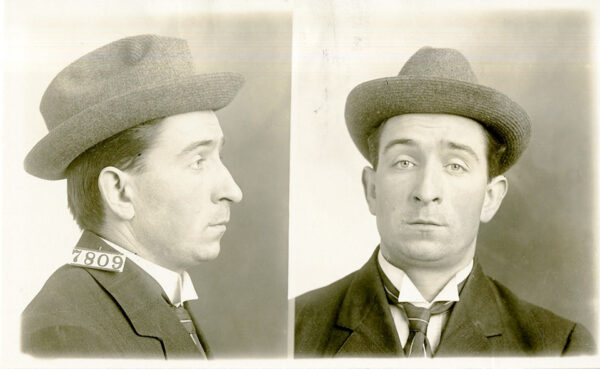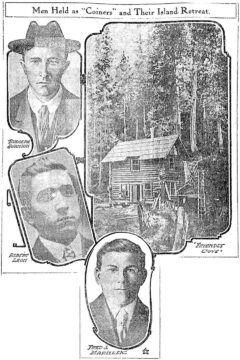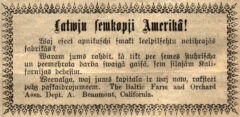
Starting in the spring of 1911, counterfeit $10 bills of reportedly remarkable quality appeared in a number of western and midwestern American states. By the end of the year, authorities had charged three Latvian immigrants with making and distributing the phony money.
The three men were identified in various newspaper reports as Albert Leon, Fred Marneek, and Rudolph Swanson. A fourth man, Oscar Litchen, also was named but not charged. They worked out of a small shack on remote Nootka Island in Canada’s British Columbia, living in what was described as an anarchist colony. Leon, the so-called mastermind of the group, produced the bills in part through a photographic process.

The banknotes were not like those in circulation today in the United States. The Federal Reserve system was not established until late 1913 and the first Federal Reserve banknotes appeared the following year. Before then, banknotes were issued by banks, and it is these that Leon and his partners counterfeited. The U.S. Currency Education Program offers a timeline of banknote development.
I only recently began researching this bit of Latvian immigrant history as a tangent to distraction from a larger project on the ethnic press. At this point, the research relies on only a few newspaper articles, census data, and some other documents. However, it is enough to begin to tell a story.
My interest was sparked by a short item from Chicago that appeared in the Jan. 4, 1912, edition of the Baptist periodical Avots, published in Rīga. “Latvians Alberts Leons, Fricis Mūrnieks, and someone named Svansons have been sentenced to 10 years in prison for counterfeiting and distributing $10 banknotes,” correspondent Jānis Miezis wrote. “It was a big search and chase before they were caught. All we Latvians were scared. The newspapers are saying that Latvian refugees in a free land do not know how to use their great freedom.”1
Curiosity piqued, I began searching online for newspaper stories and before long had found a handful from New York, Chicago, Victoria, and other locations, as well as a couple of book references.2
From these, the outlines of the story became clearer. Leon, Marneek and Swanson (the anglicized names used in the U.S. and Canadian press and in government documents) ran a counterfeiting operation from Nootka. The counterfeit $10 notes they created were facsimiles of bills issued by about a dozen U.S. banks and were distributed in California, Oregon, Washington, Illinois, and New York. At some point, the U.S. Secret Service got on the case and managed to track Marneek and Swanson to Chicago, where they were arrested in September or October.
Authorities raided the operation at Nootka but found no one there, although they discovered “some splendid cameras and other paraphernalia, and some notes in the process of photographing.”3
Meanwhile, Marneek and Swanson talked, which led authorities to New York, where on Oct. 9 they arrested Leon as he was booking passage by ship to British Guyana.
All three men were convicted. Leon and Marneek received 10-year sentences in the federal penitentiary at Leavenworth, Kansas, while Swanson got five years. Litchen was set free, apparently because he cooperated with authorities.
However, here’s where my research took a turn. Something about Leon and Marneek sounded familiar, and in reading The Daily Colonist from Victoria, I found the connection: “Leon arrived in this country about three years ago,” according to the wire service story datelined Washington, D.C. “He took up a section of land near Beaumont, Los Angeles, Cal., where it is believed the first spurious notes were made.”

Beaumont!? This has been another research topic on my “to do” list, because between 1909 and 1910, a group of Latvian immigrants established The Baltic Farm and Orchard Association, an agricultural cooperative that planned to buy land in southern California and plant apple, pear, and cherry trees.4 I haven’t dug too deeply into the association yet, but it was advertised in Latvian periodicals in the United States and in the homeland between 1909-1910.5 According to one announcement, the original eight directors of the association were were J. Kalnin, O. Litchen, J. Marneek, Ch. Ottemere, Ch. Pawarin, Martin Pujat, A. Pupur, and Ch. Swans.
So, Litchen and Marneek, co-conspirators in the counterfeiting case, were both directors of the association. Not only that, but both Leon and Marneek bought land at Beaumont. Leon paid $700 for a five-acre lot in August 19096 — and I have to wonder whether he used $10 banknotes!
Much more research remains. Questions I am exploring include:
- Whether The Baltic Farm and Orchard Association was a front for laundering the Leon gang’s counterfeit banknotes, or a legitimate effort to create a Latvian cooperative that fell victim to the gang.
- If Leon and the others really were anarchists. Their operation at Nootka was described as an anarchist commune, and they were not the only Latvians based there. Interestingly, when he was arrested Leon told authorities he was a vegetarian, and anarchism and vegetarianism sometimes went hand-in-hand.
- Leon’s prowess as a counterfeiter and where he developed his skills. A number of counterfeiting operations in Latvia had been broken up by imperial Russian authorities by the time Leon arrived in the U.S., so it is possible that he gained experience in the homeland.
- The counterfeiters’ ethnic identity. As was the practice at the time, news reports referred to them as Russian, but census records leave little doubt that Marneek and Swanson were Latvian, while Leon may have been Jewish. However, the New York Herald in one story identified Leon as “a young Lettish artist,” while according to the New York Sun he was “German born of Lettish parents.”7
Also to be determined is what happened to all these characters once their time in Leavenworth had been served. I have found nothing yet on Swanson. Marneek may have taken to the life of a sailor, according to some documents. Leon also seemed to disappear, although he left behind one example of his talent — a work of art depicting Jesus Christ breaking bread with two inmates. Unfortunately, the art was destroyed during a 1992 prison riot, according to Kenneth M. LaMaster.8
1. J. Miezis, “Latvieši Amerikā,” Avots 12:1 (January 4, 1912), p. 12.
2. See, for example, “Gang on Lonely Isle Ran Money Mill,” The New York Times, October 10, 1911, p. 5; “Captive Called ‘Coiners’ Chief,” Chicago Daily Tribune, October 10, 1911, p. 3; and “Counterfeiter Was At Nootka,” The Daily Colonist, Victoria, British Columbia, October 10, 1911, pp. 1-2. See also E. Waterman, “Albert Leon, Master Counterfeiter,” The Shoulder Strap, No. 7 (Winter 1942), 97-102, as well as Rosemary Neering, British Columbia Bizarre: Stories, Whimsies, Facts, and a Few Outright Lies from Canada’s Wacky West Coast (Victoria: TouchWood Editions, 2011), pp. 8-11. Some of the counterfeiters’ story also is told in “The B.C. Counter Culture,” Red Lion Publishing http://vcmtalk.com/the_bc_counter-culture, accessed July 13, 2017.
3. “Counterfeiter Was At Nootka,” The Daily Colonist, October 10, 1911, pp. 1-2.
4. See “Beaumont Sales Best in Months,” Los Angeles Sunday Herald, November 21, 1909, p. 32, and “Beaumont Land Attracts Buyers,” Los Angeles Sunday Herald, November 28, 1909, Part IV, p. 1, which described the association as “a co-operative organization of Swedish (sic!) people who are preparing to raise apples and other fruits on a large scale.” It is not clear why the Herald reported that Swedes were involved in the cooperative, rather than Latvians.
5. Oskars Littschens, “Latvieši kā augļu koku audzinātāji Dienvidus Kalifornijā,” Pērkons, Philadelphia, Pennsylvania, February 1910, p. 20; Oskar Litschen, “Mūsu sabiedrība,” Pērkons, April-May 1910, pp. 41-42.
6. “Swedish Colony May Settle at Beaumont,” Los Angeles Sunday Herald, August 29, 1909, Part II, p. 2.
7. “Artist Arrested as Counterfeiter,” New York Herald, Oct. 10, 1911, p. 9; “Nabbed for Bad $10 Bills,” New York Sun, Oct. 10, 1911, p. 4.
8. Kenneth M. LaMaster, ed., U.S. Penitentiary Leavenworth (Charleston, South Carolina: Arcadia Publishing, 2008), p. 64. Leon’s accomplishments were noted in newspaper and magazine articles. See, for example, “Turns Talent to Account,” The House Pioneer News, House, New Mexico, March 24, 1916, p. 8.
Accessed on 20 Apr 2024.
The article may be found online at https://straumanis.com/2017/counterfeiters-and-anarchists/.
